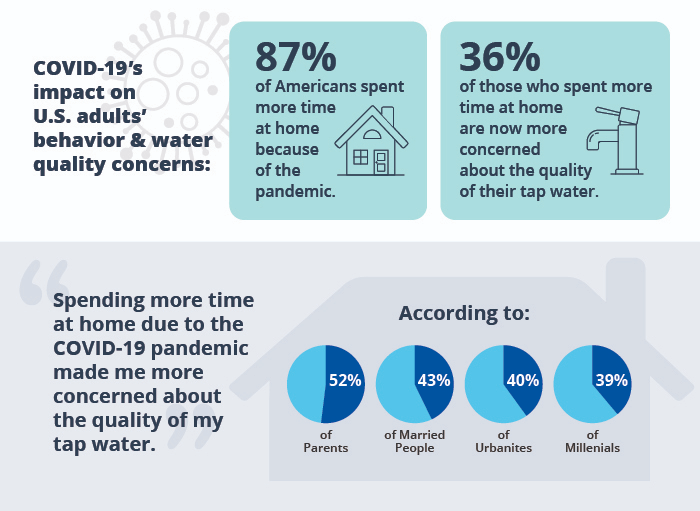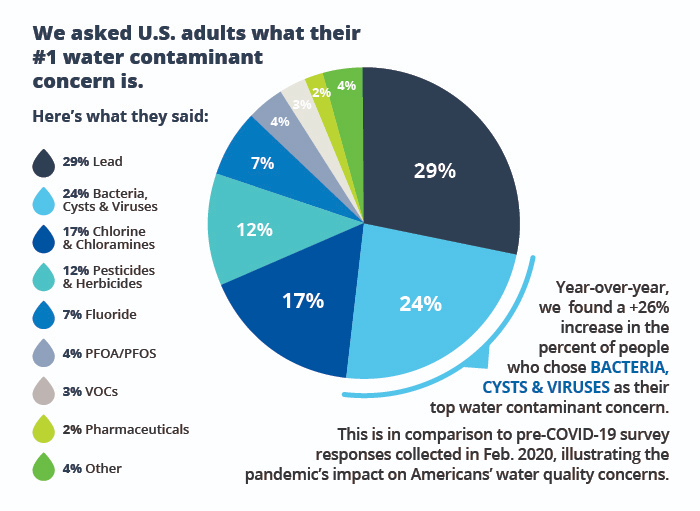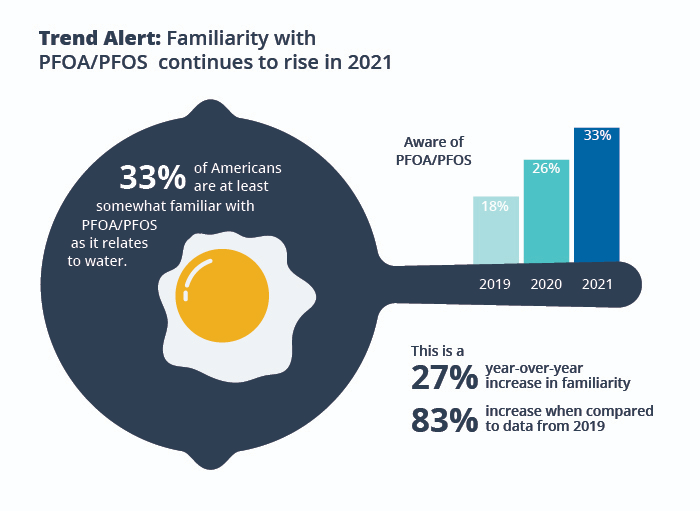The increased awareness is likely tied to several factors. Recent films like Dark Waters and The Devil We Know have increased mainstream media coverage of the contaminants. Additionally, these “forever chemicals” recently made national news when rain that fell in Ohio contained a surprisingly high amount of toxic PFAS.
PFOA/PFOS has also been a hot topic in the political circuit following a health advisory released by the EPA in 2016 and an action plan unveiled in 2019 and updated in 2020. Furthermore, in February 2021 the EPA re-proposed a rule to collect data on 29 PFAS chemicals in drinking water, and the agency took steps to develop enforceable drinking water standards. These events and others have likely contributed to the increased awareness around PFOA/PFOS in recent years.
Behavior Gaps Between Top Water Contaminant Concerns and Most Commonly Used Water Filters
In line with our findings from last year, we found nearly three-quarters (74%) of Americans filter their water at home, with 40% of respondents saying they use a pitcher water filter. This is striking, considering most pitcher filters aren’t certified to remove the top contaminant concerns, such as lead. The same is also true for the next most popular type of water filter: refrigerator filters, which account for 34% of usage.
We found that although pitchers filters are the most popular type of water filter, only 12% of people believe they are the most trustworthy source of drinking water. Trust is even lower for refrigerator water filters, where only 4% of individuals believe they are the most trustworthy source of drinking water. This interestingly shows that the most commonly used water filters aren’t the most trusted sources of clean drinking water.
So what are the most trusted sources of drinking water? We asked people this question and compared the results to our findings from 2020 to see how behaviors have changed in the past year.
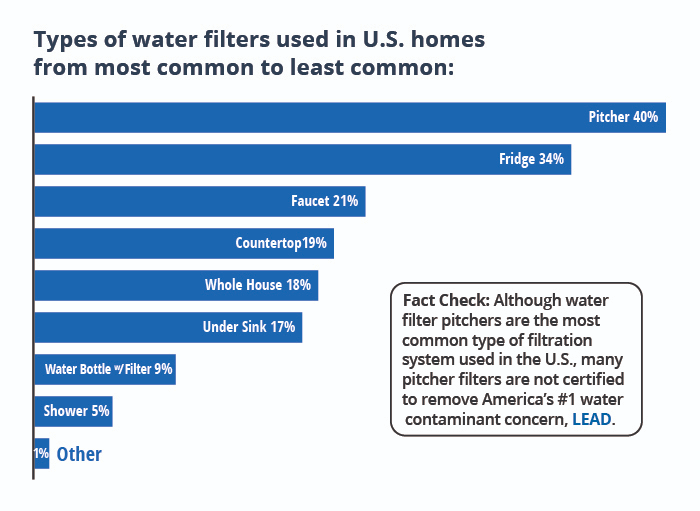
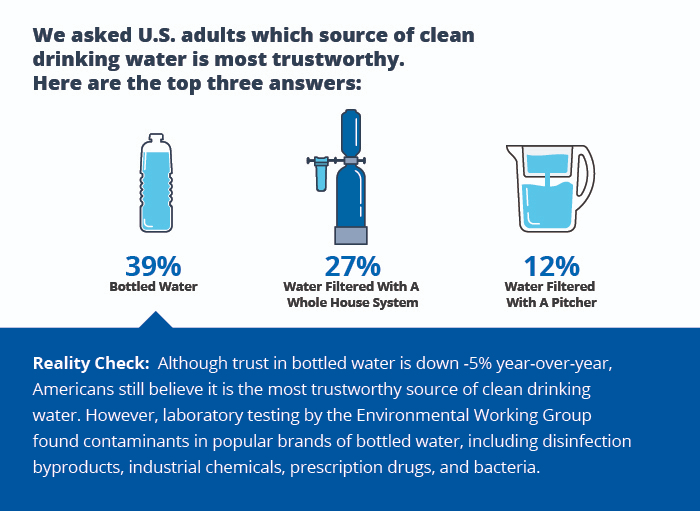
The most trusted source of drinking water remains bottled water with 39% of the vote, though the number of people who identified it as such is down -5% year-over-year from 41% in 2020. Decreased trust in bottled water may be linked to increased awareness that bottled water is not regulated by the FDA, unlike tap water which has federal drinking water standards for contaminants. In fact, a study by the Environmental Working Group found 38 contaminants in water bottles from 10 major brands including instances where contaminant levels exceeded legal limits.
The next most trusted source of drinking water was whole house filters, which is down -7% year-over-year from 29% in 2020 to 27% in 2021. Although usage of whole house filters is much lower compared to water filter pitchers, trust is higher and for good reason. Whole house water filters are one of the most effective ways to get clean, healthy drinking water throughout your entire home. However, before buying any filter you should always check to see if it’s been tested and certified by an independent third party such as NSF and IAPMO. All Aquasana water filters have been tested and certified, and you can even filter our product catalog by certifications and specific contaminants you’d like to filter.
Key Findings
To summarize, in support of National Water Quality Month we set out to gain insight into several issues regarding water quality.
This year, we found COVID-19 had a profound impact on Americans’ behavior and concerns, as people who spent extra time at home throughout the year are now more concerned with their water quality than they were prior to the pandemic. There was also an increase in demand for bottled water, which remained the most trusted source of healthy drinking water even though that trust declined year-over-year.
There was also a significant increase in the percent of people who chose bacteria, cysts, and viruses as their number one water contaminant concern, which was likely tied to concern about viruses spreading through drinking water. Awareness for PFOA/PFOS also continues to rise, with Millennials being the most likely generation to rate it as their top water contaminant concern for the second year in a row.
Our new survey data also indicates there is a behavior gap between the top water contaminants that concern Americans and the most commonly used water filters. Many of the most popular types of water filters (pitcher filters and refrigerator filters) aren’t certified to remove people’s top contaminant concerns, such as lead. Furthermore, despite their widespread use — pitcher and refrigerator filters aren’t the most trusted source of drinking water. That honor goes to bottled water, though trust has dropped over the past year.
These are just some of the notable findings from this year’s research. We’ll continue releasing survey findings throughout the rest of 2021 in future posts.
Survey Methodology and Definitions
The findings presented in this article are the result of a March 2021 study of 2,143 U.S. adults, ages 18-79, conducted by Aquasana. (Confidence Level: 95%, Margin of Error: 2%)
Survey definitions
Age Cohorts (based on Pew Research)
- Baby Boomers: 1946-64
- Gen X: 1965-80
- Millennials: 1981-96
- Gen Z: 1997-2012
Regions (based on U.S. Census map)
- Northeast: Maine, Massachusetts, New Hampshire, New Jersey, New York, Pennsylvania, Rhode Island, Vermont, Connecticut
- Midwest: Illinois, Indiana, Iowa, Kansas, Michigan, Minnesota, Missouri, Nebraska, North Dakota, Ohio, South Dakota, Wisconsin
- South: Alabama, Georgia, Kentucky, Louisiana, Maryland, Mississippi, North Carolina, Oklahoma, South Carolina, Arkansas, Tennessee, Texas, Virginia, West Virginia, Delaware, Florida
- West: Idaho, Alaska, Montana, Nevada, Arizona, New Mexico, Oregon, Utah, Washington, Wyoming, California, Colorado, Hawaii
Urban, Suburban, and Rural Classifications
- The urban, suburban, and rural classifications we use are based on the database and definitions from Great Data, which developed their logic using U.S. Census data.

